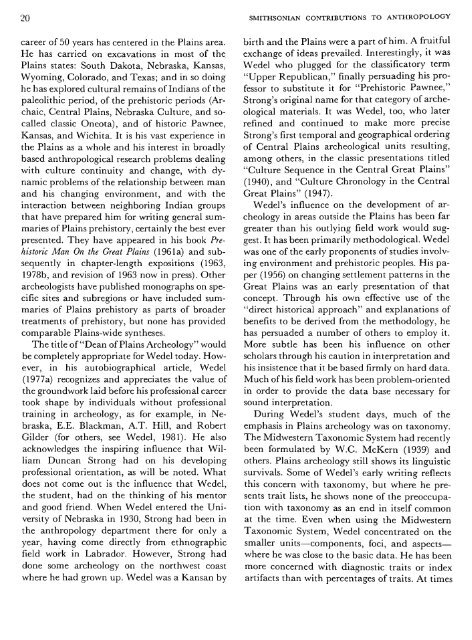Plains Indian Studies - Smithsonian Institution Libraries
Plains Indian Studies - Smithsonian Institution Libraries
Plains Indian Studies - Smithsonian Institution Libraries
Create successful ePaper yourself
Turn your PDF publications into a flip-book with our unique Google optimized e-Paper software.
20 SMITHSONIAN CONTRIBUTIONS TO ANTHROPOLOGY<br />
career of 50 years has centered in the <strong>Plains</strong> area.<br />
He has carried on excavations in most of the<br />
<strong>Plains</strong> states: South Dakota, Nebraska, Kansas,<br />
Wyoming, Colorado, and Texas; and in so doing<br />
he has explored cultural remains of <strong>Indian</strong>s of the<br />
paleolithic period, of the prehistoric periods (Archaic,<br />
Central <strong>Plains</strong>, Nebraska Culture, and socalled<br />
classic Oneota), and of historic Pawnee,<br />
Kansas, and Wichita. It is his vast experience in<br />
the <strong>Plains</strong> as a whole and his interest in broadly<br />
based anthropological research problems dealing<br />
with culture continuity and change, with dynamic<br />
problems of the relationship between man<br />
and his changing environment, and with the<br />
interaction between neighboring <strong>Indian</strong> groups<br />
that have prepared him for writing general summaries<br />
of <strong>Plains</strong> prehistory, certainly the best ever<br />
presented. They have appeared in his book Prehistoric<br />
Man On the Great <strong>Plains</strong> (1961a) and subsequently<br />
in chapter-length expositions (1963,<br />
1978b, and revision of 1963 now in press). Other<br />
archeologists have published monographs on specific<br />
sites and subregions or have included summaries<br />
of <strong>Plains</strong> prehistory as parts of broader<br />
treatments of prehistory, but none has provided<br />
comparable <strong>Plains</strong>-wide syntheses.<br />
The title of "Dean of <strong>Plains</strong> Archeology" would<br />
be completely appropriate for Wedel today. However,<br />
in his autobiographical article, Wedel<br />
(1977a) recognizes and appreciates the value of<br />
the groundwork laid before his professional career<br />
took shape by individuals without professional<br />
training in archeology, as for example, in Nebraska,<br />
E.E. Blackman, A.T. Hill, and Robert<br />
Gilder (for others, see Wedel, 1981). He also<br />
acknowledges the inspiring influence that William<br />
Duncan Strong had on his developing<br />
professional orientation, as will be noted. What<br />
does not come out is the influence that Wedel,<br />
the student, had on the thinking of his mentor<br />
and good friend. When Wedel entered the University<br />
of Nebraska in 1930, Strong had been in<br />
the anthropology department there for only a<br />
year, having come directly from ethnographic<br />
field work in Labrador. However, Strong had<br />
done some archeology on the northwest coast<br />
where he had grown up. Wedel was a Kansan by<br />
birth and the <strong>Plains</strong> were a part of him. A fruitful<br />
exchange of ideas prevailed. Interestingly, it was<br />
Wedel who plugged for the classificatory term<br />
"Upper Republican," finally persuading his professor<br />
to substitute it for "Prehistoric Pawnee,"<br />
Strong's original name for that category of archeological<br />
materials. It was Wedel, too, who later<br />
refined and continued to make more precise<br />
Strong's first temporal and geographical ordering<br />
of Central <strong>Plains</strong> archeological units resulting,<br />
among others, in the classic presentations titled<br />
"Culture Sequence in the Central Great <strong>Plains</strong>"<br />
(1940), and "Culture Chronology in the Central<br />
Great <strong>Plains</strong>" (1947).<br />
Wedel's influence on the development of archeology<br />
in areas outside the <strong>Plains</strong> has been far<br />
greater than his outlying field work would suggest.<br />
It has been primarily methodological. Wedel<br />
was one of the early proponents of studies involving<br />
environment and prehistoric peoples. His paper<br />
(1956) on changing settlement patterns in the<br />
Great <strong>Plains</strong> was an early presentation of that<br />
concept. Through his own effective use of the<br />
"direct historical approach" and explanations of<br />
benefits to be derived from the methodology, he<br />
has persuaded a number of others to employ it.<br />
More subtle has been his influence on other<br />
scholars through his caution in interpretation and<br />
his insistence that it be based firmly on hard data.<br />
Much of his field work has been problem-oriented<br />
in order to provide the data base necessary for<br />
sound interpretation.<br />
During Wedel's student days, much of the<br />
emphasis in <strong>Plains</strong> archeology was on taxonomy.<br />
The Midwestern Taxonomic System had recently<br />
been formulated by W.C. McKern (1939) and<br />
others. <strong>Plains</strong> archeology still shows its linguistic<br />
survivals. Some of Wedel's early writing reflects<br />
this concern with taxonomy, but where he presents<br />
trait lists, he shows none of the preoccupation<br />
with taxonomy as an end in itself common<br />
at the time. Even when using the Midwestern<br />
Taxonomic System, Wedel concentrated on the<br />
smaller units—components, foci, and aspects—<br />
where he was close to the basic data. He has been<br />
more concerned with diagnostic traits or index<br />
artifacts than with percentages of traits. At times

















